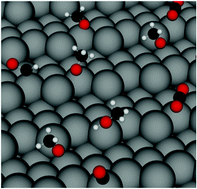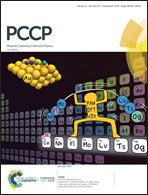Methanol oxidation on the Pt(321) surface: a theoretical approach on the role of surface morphology and surface coverage effects†
Abstract
We investigated methanol oxidation, decomposition and carbonylation reactions on a high indexed Pt(321) surface. Adsorption studies of the reactants and reaction products were analyzed, where the favourable binding was found on the low coordinated atoms which are located on the step edges of this surface. The dependence of the reaction mechanism on the surface structure could be observed by analysis of methanol decomposition via O–H and C–H bond cleavage, where the latter showed a significant preference in energy. Compared to flat surfaces, the stepped and kinked Pt(321) surface showed a much stronger adsorption behavior towards methanol decomposition exhibiting small activation barriers. The consideration of higher coverage of molecules, e.g. water, during the decomposition reaction showed significant reduction of the corresponding activation barriers. Finally, the influence of a second metal such as Au or Pd in the Pt(321) surface reduced the CO poisoning of the reactive steps and kinks by the formation of carbon dioxide resulting in the accessibility of the reactive surface atoms for next/further reaction steps.



 Please wait while we load your content...
Please wait while we load your content...